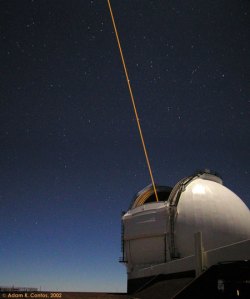Lasers, telescopes & aeroplanes
Posted: October 30, 2009 Filed under: Uncategorized | Tags: adaptive optics, laser, telescope 3 Comments[tweetmeme only_single=false service=”wp.me” source=”allinthegutter”]
So this post was supposed to be about the discovery of the most distant galaxy ever found, at a redshift of about 8.2 (13.1 billion light years from us, or, to put it another way, only about 630 million years after the Big Bang), but I didn’t get round to it yesterday and I’ve now been distracted by a paper out today on telescopes, laser beams and aeroplanes instead! (For more details on the distant galaxy see this post over at the always excellent In the Dark. There’s a lot of effort being put into this field at the moment, as already discussed here by Rita, so I expect there’ll be a new ‘most distant’ one that I can catch up with soon.)
One of the main problems astronomers face when trying to observe things in the sky is the turbulence in the Earth’s atmosphere, from clouds, wind etc (this is known as ‘seeing’ and is what causes the stars to twinkle). To get away from this telescopes are normally built high up on mountains, above as many of the clouds as possible, or, like the Hubble Space Telescope, put into orbit where there’s no atmosphere to worry about.

Putting a telescope on a mountain doesn’t completely avoid all the atmospheric distortions, but a technique called adaptive optics can help to correct it. This needs a nice bright star in the field of view, but when this isn’t available an artificial star can be created by shooting a laser beam into the sky, as shown for the Keck Telescope in the picture above. The telescope then observes this ‘star’, and uses its fluctuations in shape (due to the current patch of atmosphere overhead at the time) to correct the astronomical images as they are observed. I should add here that this isn’t the only time lasers are used alongside telescopes – for example they are also fired at the reflectors left on the moon by the Apollo missions, as I’ve blogged about before.

The benefit of adaptive optics for a galaxy observed at the Canada-France-Hawaii Telescope. Left: with correction, right: without
The only flaw in this telescopes-lasers-great corrected, pictures of the sky/laser ranging plan is aeroplanes. Laser beams can dazzle pilots so understandably they can’t be used at the telescopes when planes are in the vicinity. What this has meant in practice up till now is someone sitting outside all night, ready to close the laser-shutter when one comes too close. Not very practical and a pretty boring job! Well, now some researchers in California have come up with a solution. Aviation regulations require that all aircraft are fitted with transponders so that they can be tracked by air-traffic control. By measuring the ratio of transponder signal power from two antennae aligned with the laser, one broad and one narrow beam, the position of the aircraft can be found. An automated shutter can then be activated to turn the laser off, and the cold plane-watchman can go back inside.
![]() W. A. Coles, T. W. Murphy Jr., J. F. Melser, J. K. Tu, G. A. White, K. H. Kassabian, K. Bales, & B. B. Baumgartner (2009). A Radio System for Avoiding Illuminating Aircraft with a Laser Beam submitted to PASP arXiv: 0910.5685v1
W. A. Coles, T. W. Murphy Jr., J. F. Melser, J. K. Tu, G. A. White, K. H. Kassabian, K. Bales, & B. B. Baumgartner (2009). A Radio System for Avoiding Illuminating Aircraft with a Laser Beam submitted to PASP arXiv: 0910.5685v1


Who invented the mechanism that shuts down the laser? Thank you so much for this explanation. I was at a lecture last night about the 30 meter telescope that will be built next to the Keck and I didn’t have an opportunity to ask this question.
As far as I know the automatic mechanism was invented by the authors of the paper I cited in my post – W. A. Coles, T. W. Murphy Jr., J. F. Melser, J. K. Tu, G. A. White, K. H. Kassabian, K. Bales, & B. B. Baumgartner. They’re all listed as researchers at the University of California.
[…] The telescopes seen in the film make up the Very Large Telescope in Chile. The lasers they fire are used to improve the quality of their observations. […]